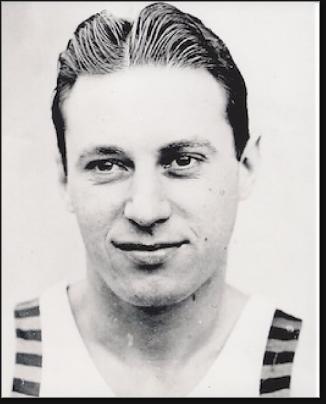
Sport: Basketball
Born: July 10, 1913
Died: October 28, 2010
Town: Paterson, New Jersey
Phillip Rabinowitz was born July 10, 1913 in Paterson, NJ. Phil’s sports heroes were the Paterson Crescents, one of the top basketball teams in the Metropolitan area during the 1920s. As a boy, he would volunteer to carry the players’ bags to get into games for free. Phil and his brother learned to play shooting at a peach basket and dribbling on wooden planks. They moved to a proper playground when Phil was 10.
An adept shooter and slippery ball handler, Phil was a tough, wiry 5’9” forward in high school. He enrolled at Long Island University in 1931 and became a standout player for coach Clair Bee in the early 1930s. LIU had a nationally ranked team at the time, and Phil often played in front of 10,000 or more fans at Madison Square Garden. During his senior year, Phil also played a handful of games for a pro team in South Jersey under the name Fish Rabin. When this was discovered it ended his college career.
Phil signed with the Paterson Panthers of the American Basketball League. After five games, the team moved to Trenton and then finished the season in Passaic. Phil averaged 8.6 points per game, the second-best mark in the ABL that season. He played several seasons for the Kington Colonials in upstate New York and captured three ABL scoring titles. He typically scored between 10 and 20 points a game—a big number when winning teams usually finished with 30 to 40. His teammates in Kingston included two other New Jersey hoops standouts, Carl Husta and Rusty Saunders.
Phil was a shoot-first offensive player who did not always fit well into a team concept. The Jersey Reds signed Phil toward the end of the 1938–39 season, but he got into a feud with the team’s go-to guy, Moe Spahn, and then injured his wrist in the playoffs. The Reds, defending champions of the ABL, were swept in the finals.
The following year, Phil played with the team-oriented Philadelphia SPHAs and was the highest-paid player in the ABL. Resented by his lower-compensated teammates, he was traded to the Washington Brewers after a month—where he was again among the ABL scoring leaders.
Phil met his future wife, Butchie, during this time when he went into the stands during a game trying to save the ball and broke her glasses. She thought he was obnoxious at first but they were married a year later.
Phil was always in demand and, during his prime, he suited up for several different teams at the same time—often playing 6, 7 or even 8 games a week. Unfortunately, the wear and tear eventually caught up with him. Phil ruptured his Achilles tendon in 1940 and later was one of the first athletes to have both knees operated on at the same time.
Although Phil returned to the court, he was never the same player again. He was 4-F during World War II and worked a defense job. He suited up for the New York Jewels but his legs had lost their spring. In 1944, Phil played in a benefit game for the March of Dimes, after which he was given a gold pendant by President Franklin Roosevelt.
Phil finished his pro career in his hometown, with the Paterson Crescents, in 1946. One of his teammates was Chuck Connors, who’d played for Seton Hall. In his 30s and battling chronic injuries, Phil called it a career just as pro hoops was expanding with the start of the Basketball Association of America, the forerunner of the NBA.
Before Phil passed away in Florida in the fall of 2010, he was believed to be the oldest living professional basketball player, at age 97.